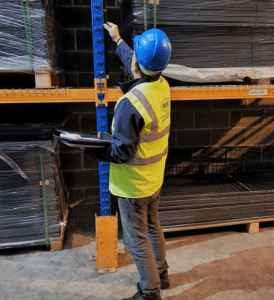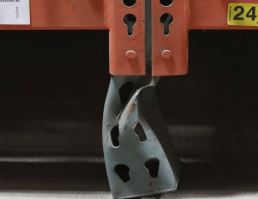Pallet racking systems support efficient storage and organization and are critical to any warehouse, distribution center, or manufacturing plant. However, keeping these systems safe and functional requires regular inspections and maintenance.
Why are Pallet Rack Inspections Important?
The primary reason for inspections is safety. A damaged or improperly installed racking system can collapse, leading to potential injuries, equipment damage, and financial losses. Regular rack inspections help identify issues early, allowing for prompt repairs or adjustments to avoid accidents.
damage, and financial losses. Regular rack inspections help identify issues early, allowing for prompt repairs or adjustments to avoid accidents.
OSHA Requirements for Pallet Racking Safety
The Occupational Safety and Health Administration (OSHA) is the main regulatory body overseeing workplace safety in the United States. While OSHA doesn’t have specific standards solely for pallet racking systems, they enforce general requirements for maintaining a safe working environment. Here are some key points:
- Structural integrity: Under OSHA’s General Duty Clause, employers must provide a workplace free of recognized hazards. This means keeping pallet racks in good condition, free from damage that could lead to collapse.
- Proper load handling: OSHA requires proper training for employees working with and around pallet racks, including weight capacity limits and how to load or unload items. Overloading racks beyond their rated capacity can lead to collapse, violating OSHA safety guidelines.
- Labeling and signage: All pallet racks must have clearly visible load capacity labels. OSHA requires that these labels be maintained and that the racks are not overloaded.
- Access and housekeeping: Clear aisles and proper housekeeping are crucial. Positioning racks so that there is adequate clearance for forklifts and other vehicles reduces the risk of accidental damage.
Rest assured, Abel Womack’s storage solutions team takes into account these requirements when designing racking systems for our customers.
FM Global Guidelines for Pallet Racks
FM Global is a widely used insurance provider in the warehousing industry. They are heavily focused on risk management, providing guidelines to minimize damage and risks in storage areas. These guidelines are particularly relevant for facilities insured by FM Global and are helpful benchmarks for other businesses.
- Rack design and installation: FM Global recommends that professionals install racks according to the manufacturer’s guidelines, including ensuring the system is anchored securely to the floor to avoid tipping.
- Damage control: They advise implementing a regular inspection program, including identifying and repairing damaged uprights, beams, and braces. Even minor damage can compromise the entire system’s integrity, making inspections vital.
- Fire protection considerations: FM Global emphasizes the need for sprinkler systems designed specifically for the type of racking and the materials being stored. Rack systems can obstruct water distribution during a fire, so it’s critical to have an adequate fire suppression system in place.
- Earthquake safety: FM Global advises securing racks with appropriate bracing to prevent collapse during seismic events in earthquake-prone areas.
As part of our service, Abel Womack will check with our customer’s insurance company and the city’s  requirements to ensure our racking installations are always compliant.
requirements to ensure our racking installations are always compliant.
Best Practices for Pallet Rack Inspections
Here are some best practices for staying compliant with OSHA and FM Global rack requirements:
- Frequency of pallet rack inspections: Regular inspections are crucial. Daily visual checks for apparent damage can be supplemented with a more formal monthly or quarterly inspection. You may need to adjust the frequency depending on the operational environment and the risk factors involved.
- What to look for: Inspections should focus on signs of wear, rust, bending, or other visible damage to uprights, beams, and connectors. Ensure all racks are secured to the floor and that no components are
 missing. Some common items found in many rack inspections are:
missing. Some common items found in many rack inspections are:
- Missing or damaged anchors
- Damaged upright frames from forklift impacts
- Missing capacity signs
- Missing or damaged pallet supports and beams
- Damaged wire decking
- Employee training: Train employees to recognize damage and report it immediately. For instance, forklift operators should know the consequences of damaging racks and the importance of notifying supervisors if an impact occurs.
- Documentation: Keep detailed records of inspections, including any corrective actions taken. This documentation can be valuable in demonstrating compliance with regulatory bodies and insurance companies.
- Bring in a qualified expert: Your local material handling experts, like Abel Womack, can offer various racking options, ranging from a low-level inspection to a complete in-depth analysis performed by qualified racking engineers. These are often recommended as an annual service performed by third-party experts, with periodic inspections done by the customer, and are non-disruptive to your daily operations.
Acting on Damage
It’s important to act immediately if damage is detected during an inspection. The damaged pallet rack components should be unloaded and repaired or replaced. Never allow the use of damaged racking, as it poses a significant risk to personnel and inventory.
Next, ensuring the safety and compliance of your pallet racking system requires an understanding of both OSHA regulations and FM Global guidelines or the help of a qualified racking supplier like Abel Womack.
Regular pallet rack inspections, employee training, and prompt corrective actions are vital to maintaining a safe warehouse environment. By staying proactive, businesses can prevent accidents, minimize risks, avoid fines, and ensure their racking systems remain functional and secure.
Finally, reach out for assistance to verify new racking was installed according to engineering specifications or when preparing for an OSHA inspection or audit.




Leave a Reply
You must be logged in to post a comment.